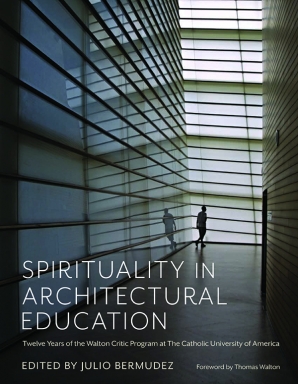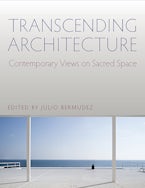- Home
- architecture
- Spirituality in Architectural Education
Preparing your PDF for download...
There was a problem with your download, please contact the server administrator.
Spirituality in Architectural Education
Twelve Years of the Walton Critic Program at The Catholic University of America
Edited by Julio Bermudez
Imprint: Catholic University of America Press
How does spirituality enter the education of an architect? Should it? What do we mean by ‘spirituality’ in the first place? Isn’t architectural education a training ground for professional practice and, therefore, technically and secularly oriented? Is there even room to add something as esoteric if not controversial as spirituality to an already packed university curriculum? The humanistic and artistic roots of architecture certainly invite us to consider dimensions well beyond the instrumental, including spirituality. But how would we teach such a thing? And why, if spirituality is indeed relevant to learning architecture, have we heard so little about it?
Spirituality in Architectural Education addresses these and many other important philosophical, disciplinary, pedagogic, and practical questions. Grounded on the twelve-year-old Walton Critic Program at the Catholic University of America School of Architecture and Planning, this book offers solid arguments and insightful reflections on the role that "big questions" and spiritual sensibility ought to play in the architectural academy today. Using 11 design studios as stopping grounds, the volume takes the reader into a journey full of meaningful interrogations, pedagogic techniques, challenging realizations, and beautiful designs. Essays from renowned architects Craig W. Hartman, Juhani Pallasmaa, Alberto Campo Baeza, Claudio Silvestrin, Eliana Bórmida, Michael J. Crosbie, Prem Chandavarkar, Rick Joy, Susan Jones, and Daniel Libeskind open new vistas on the impact of spirituality in architectural education and practice. All this work is contextualized within the ongoing discussion of the role of spirituality and religion in higher education at large. The result is an unprecedented volume that starts a long-awaited conversation that will advance architectural schooling. ACSA Distinguished Professor Julio Bermudez, with recognized expertise on spirituality in architecture, will be the guide in this fascinating and contemplative journey.
Julio Bermudez is professor of architecture and directs the Cultural Studies and Sacred Space graduate program at The Catholic University of America.
"This book is not about how to make spiritually moving buildings, but rather how to teach architecture in ways that include spiritual concerns. Bermudez’s pedagogical focus in Spirituality in Architectural Education is useful for all educators. Who does not want to be encouraged to profess the ultimate purpose of their subject? Who does not want to spark, practice, and develop consciousness in their students? This text will encourage both young and established teachers to include students’ direct experience (1st person), interaction among students and others (2nd person), and codified knowledge (3rd person) in their own teaching methods, in any subject."
~Galen Granz, University of California at Berkeley
"Reading Spirituality in Architecture Education is a spiritual journey and design pilgrimage that leads to a more holistic and humanistic way of architecture education and practice. The Walton Studio brings ‘deep questions’, awareness, and reflection to the center of contemporary architecture pedagogy. This is a wonderful book for all seeking connections between the designed, built, and spiritual worlds"
~Bradford Grant, Howard University, and former President of the Center for Contemplative Mind in Society
"Spirituality, this book shows, is nowhere if not here, in and in-between individuals like you, me, and others. Though today mostly hidden or neglected, we still somehow sense and desire it, and on reflection understand it to be necessary for a full life, like the air that we breathe and our voices modulate. We encounter spirituality in things and spaces that are similarly inspired: groves in gardens, apertures in architecture, streets and squares where people gather. Full-throated critique will be found on some of the pages in this book, prompted by profound unease with the ways that architectural education has become both stultifying and suffocating. But readers will also discover creative alternatives that explore how learning and teaching might be enlivened. For there is another education where individual voices can first be found, then cultivated, and encouraged to speak for themselves, saying what they see and showing what they desire for worlds in which all of us might live and breathe a little more freely."
~David Leatherbarrow, University of Pennsylvania


